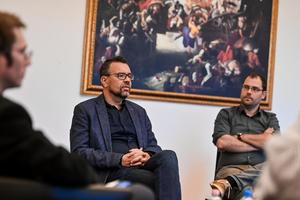The Central European Urban History thematic issue of Central European Horizons, an English-language journal of the Eötvös József Research Centre (EJRC) of the University of Public Service (UPS), has recently been published, with studies on the cities of Kassa, Rijeka, Vilnius and Transylvania by Hungarian and Romanian authors. This will be followed by another, also international, compilation later this year. In connection with the journal and the forthcoming new issue, Róbert Balogh and Csaba Zahorán, research associates of the Central Europe Research Institute, talked to Erika Szívós, associate professor and head of Department of Economic and Social History at ELTE, about the twentieth-century development of cities in Central Europe and current research trends and topics in modern urban history.
"As a Central European Research Institute, we are trying to create a forum, one of the means of which is the publication of scientific studies," said the head of the Institute in his opening speech at the event, which was held in the Zrínyi Hall of the Ludovika Main Building. Pál Hatos said that the issue of urbanisation arises in similar cases in Central Europe, but that it is easier to live and prosper in cities than in the countryside.
Csaba Zahorán presented the thematics of the current and forthcoming issues of the magazine, as well as the studies received and published in print. Erika Szívós published a study on Central European cities in the second half of the 20th century in the 2020/4. issue of Múltunk (Our Past) (The cities of Central Eastearn Europe from the Second World War to the 2000s: on the contemporary roots of our urban development today). Taking the European context as a starting point, it seeks to answer the question of when and how the processes that characterise the whole of Europe took shape in the cities of East-Central Europe, and how the specific features of the region's cities can be identified during more than half a century from 1945 to the 2000s," said Csaba Zahorán.
The cities of the more closed Eastern European countries during the period of socialist realism are not only comparable in terms of architectural paradigms, but each nation has treated the protection of historic neighbourhoods differently, Erika Szívós pointed out. In the context of migration waves, she noted that in Western European states there were sharp demarcation lines between different neighbourhoods and housing estates, while this was quite unknown to the Soviet member states of Eastern Europe and did not pose a significant problem. The researcher added, however, that the post-Soviet states of Central and Eastern Europe faced challenges after the regime change that had a major impact on the interpretation of the transformation of urban landscapes.
Experts agreed that the legacy of wars was often too great of a burden for the authorities, and "the creation of a socialist human image" was a major challenge for the populations that had moved from rural to urban areas. The Central European Urban History thematic issue of Central European Horizons, an English-language journal of the Eötvös József Research Centre (EJRC) of the University of Public Service (UPS), has recently been published, with studies on the cities of Kassa, Rijeka, Vilnius and Transylvania by Hungarian and Romanian authors. This will be followed by another, also international, compilation later this year. In connection with the journal and the forthcoming new issue, Róbert Balogh and Csaba Zahorán, research associates of the Central Europe Research Institute, talked to Erika Szívós, associate professor and head of Department of Economic and Social History at ELTE, about the twentieth-century development of cities in Central Europe and current research trends and topics in modern urban history.
"As a Central European Research Institute, we are trying to create a forum, one of the means of which is the publication of scientific studies," said the head of the Institute in his opening speech at the event, which was held in the Zrínyi Hall of the Ludovika Main Building. Pál Hatos said that the issue of urbanisation arises in similar cases in Central Europe, but that it is easier to live and prosper in cities than in the countryside.
Csaba Zahorán presented the thematics of the current and forthcoming issues of the magazine, as well as the studies received and published in print. Erika Szívós published a study on Central European cities in the second half of the 20th century in the 2020/4. issue of Múltunk (Our Past) (The cities of Central Eastearn Europe from the Second World War to the 2000s: on the contemporary roots of our urban development today). Taking the European context as a starting point, it seeks to answer the question of when and how the processes that characterise the whole of Europe took shape in the cities of East-Central Europe, and how the specific features of the region's cities can be identified during more than half a century from 1945 to the 2000s," said Csaba Zahorán.
The cities of the more closed Eastern European countries during the period of socialist realism are not only comparable in terms of architectural paradigms, but each nation has treated the protection of historic neighbourhoods differently, Erika Szívós pointed out. In the context of migration waves, she noted that in Western European states there were sharp demarcation lines between different neighbourhoods and housing estates, while this was quite unknown to the Soviet member states of Eastern Europe and did not pose a significant problem. The researcher added, however, that the post-Soviet states of Central and Eastern Europe faced challenges after the regime change that had a major impact on the interpretation of the transformation of urban landscapes.
Experts agreed that the legacy of wars was often too great of a burden for the authorities, and "the creation of a socialist human image" was a major challenge for the populations that had moved from rural to urban areas.



